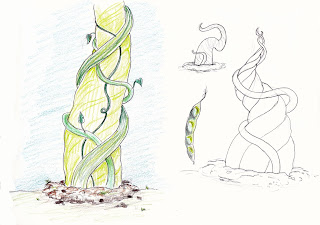Progress up to Now
Peer Feedback
The feedback we got wasn't necessarily constructive, as it only really pointed out how well animated it was and how cute the characters were, which I can only assume means people like our work and think we're doing well. I must point out that the comment about the voice actor's talent was made by the voice actress herself, and we're actually considering re-recording the voice, sadly. We're looking for someone who sounds more enthusiastic to make the overall aesthetic of the animation more cheerful. We also discussed sound design briefly, and having sat through a talk with Jan Meinema I can say that this is practically a MUST. By using subtle sounds (for example, cockerels, tractors and animals) we can really help set the scene, and make it obvious of the space that the characters are in. So if it comes to re-recording our narration, we shall have to consider the pauses we can put into the script to allow for sound effects to come through.
Prior to the peer review, I was hoping to talk to Tyler about work load as I was beginning to struggle juggling my time, and was feeling a bit overwhelmed with how much animating I had to do on my own. Now having the critique and putting all the completed (or nearly completed) scenes together, I feel much better as there's not too much left to do animating wise. He has offered to take some of the animating, but considering it would be better for us to keep the settings and positions of the characters consistent throughout the scenes, it only makes sense for me to power through with the rest of the animating. If Tyler was to take some of the work load, I would have to send him ALL my components and project files to keep the consistency which would be impractical considering the file sizes. Also, by the time I will have sat down with him to teach him how to use some of the tools I could have got the animation finished myself. If Tyler was wanting to learn how to animate in this way I would have been happy to do this, but we both think it's best to try to get the animation finished in good time so we can concentrate on post-production and get the entry submitted.
As Tyler isn't going to be taking any of the animating responsibilities, he is going to make the finishing components that I can slot into scenes; Things such as bowls, information bubbles, fences, hay bails. I also pointed out to Tyler what Mike had suggested to me, which was to try and add more depth. In some scenes we had some depth with how the kitchen had been designed for instance, and having buildings on angles, but a lot of the components felt very flat. Now, I'm not massively concerned about this as we were aiming for a paper cut look anyway, and I think this only emphases this, but I suggested that if we wanted to try and work on this, some cows could be drawn up from different angles, such as the front and back rather than just seeing them from side-on. I have left this decision up to Tyler as I would be happy with either outcome, and it makes no difference to me work load wise, as I still have to slot some cows into our existing compositions.




































